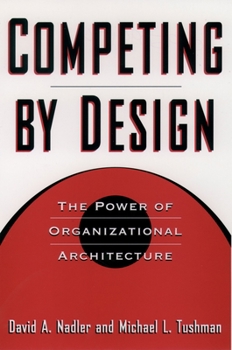Competing by Design: The Power of Organizational Architecture
Select Format
Select Condition 
Book Overview
If the defining goal of modern-day business can be isolated to just one item, it would be the search for competitive advantage. And, as everyone in business knows, it's a lot harder than it used to be. On the one hand, competition is more intense than ever--technological innovation, consumer expectations, government deregulation, all combine to create more opportunities for new competitors to change the basic rules of the game. On the other hand,...
Format:Hardcover
Language:English
ISBN:0195099176
ISBN13:9780195099171
Release Date:July 1997
Publisher:Oxford University Press
Length:256 Pages
Weight:1.21 lbs.
Dimensions:0.9" x 6.2" x 9.7"
Customer Reviews
5 ratings
A great book on the hard and soft factors of organizational design
Published by Thriftbooks.com User , 15 years ago
A great book providing a broad overview of the various organization design factors and techniques. These techniques are also embellished with good examples; in fact each chapter begins with an example. Many ideas and theories in org design (such as HPWS, Jay Galbraith's theories, BPR etc) are covered. The authors also give equal if not higher credence to the organization culture, the soft underbelly of organizational design. Several examples of theirs illustrate how even the most well planned designs go completely awry when cultural fit is not taken into consideration in the redesign. The authors have put their heart and soul into this book and it shows. I own this book and keep referring to it once in a while. The only reason to drop one star is because I would have wished for a little more visuals. It gets pretty dry, especially towards the end.
Excellent overview
Published by Thriftbooks.com User , 21 years ago
This is a good book for both practitioners and academics. Full coverage of many topics.
Good Start
Published by Thriftbooks.com User , 23 years ago
This is a very good start for Org Design consultants. The book correct addresses the key principles in designing an organization (Chap. 3) and explores the key issues that affect the key crucial design issues (Chap. 4). Don't wait for a "how to" book, this is much more a "what" one.
Organizational design made feasible
Published by Thriftbooks.com User , 23 years ago
Competing by design is a great source for for anybody who thinks about organizational design. After having read it, you will never consider "cocktail-napkin" designs again, and you will recognize when you see a design created that way. The book doesn't only explain the basic elements of design, but also the do's and dont's of a design project. The structure of the book is very well-conceived, and the level of detail is just right: Focus on the important steps, best practices and lessons, with enough backup examples, and without boring repetitions or lenghthy explanations. I'm not sure you will sleep better after having read the book, as the size of the design project becomes clear, but you will certainly have the tools to make the process a successful one.
"The Lessons of Design."
Published by Thriftbooks.com User , 24 years ago
"Today, more and more companies are coming to realize that they can't hope to compete successfully in the twenty-first century with organizations based on nineteenth-century design. Radically different organizational architectures are emerging in much the same fashion as new schools of physical architecture...In order to perform effectively, the new architectures require new collateral technologies. In particular, they demand new leadership skills, new methods for selecting and developing key people, new human resources approaches to assessment and reward, and new techniques for enhancing the organization's capacity for collective learning...In this book, we consider a number of leading companies in the United States and around the world that are developing their own versions of the new architecture.(pp.7-10)."Throughout this study, David A. Nadler and Michael L. Tushman present a comprehensive, balanced approach to design that recognizes the technical requirements, human dynamics, and strategic demands of successful design in any organization or business unit. Nadler and Tushman summarize the ten basic themes that capture the essence of this book :1. Organizational capabilities represent the last truly sustainable source of competitive advantage.2. Organizational architecture provides a conceptual framework for employing strategic design to develop organizational capabilities.3. At every level of the organization, design constitutes one of the most powerful tools for shaping performance.4. Regardless of its scope or scale, there are certain fundamental concepts that apply to design at every level.5. There is a logical sequence of actions and decisions that applies to the design process at any level of the organization.6. There are no perfect design; the design process requires the weighing of choices and the balancing of trade-offs.7.The best designs draw upon the knowledge, experience, and expertise of people throughout the organization.8. Even the best designs can be derailed by ill-planned, poorly executed implementation.9. As continual redesign becomes a fact of life, successful organizations will learn to create flexible architectures that can accommodate constant change.10. Flexible architectures and designs that leverage competitive strengths will themselves become the ultimate competitive weapons. I highly recommend.






